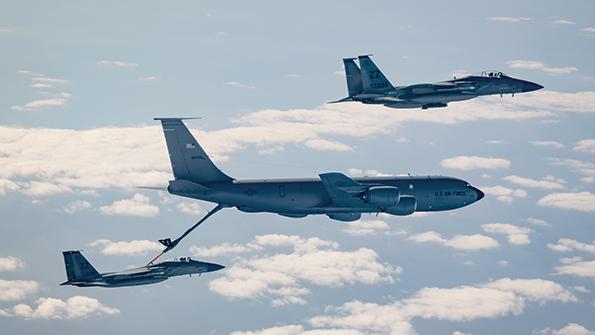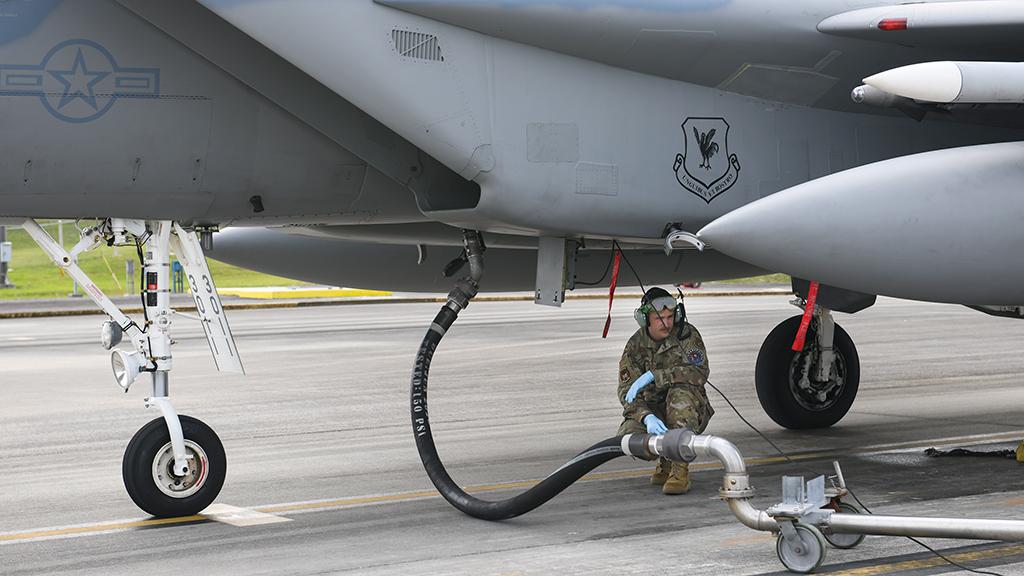
The technological details of the U.S. Air Force’s new approach to fighting an air war in the next decade are still being fine-tuned in laboratory experiments and simulation centers, but a few of the dramatic changes are already visible here at Kadena AB on the rocky shores of Okinawa, Japan.
- Rumrunner event tested base defenses
- Logistics-under-attack effort proposed
A local exercise held in January called WestPac Rumrunner appeared to be built around a routine counter-air scenario: Twenty-four Boeing F-15Cs scrambled from Kadena AB to a point about 100 mi. east of the island to intercept “invading” U.S. Navy Boeing F/A-18E/Fs launched from MCAS Iwakuni on Japan’s mainland. Meanwhile, Special Operations Forces (SOF) aircraft attempted to infiltrate a team of commandos on the island.
Underlying that routine setup, however, was a glimpse of the future. Four Kadena-based F-15Cs refueled and rearmed during the exercise at MCAS Futenma on Okinawa. Another mainland Japan-based Navy E-2D, which supported Kadena’s F-15Cs against the invading F/A-18E/Fs and SOF teams, refueled at Kadena. Although those seem like trivial logistical details, both offered a chance to test the Air Force’s new Agile Combat Employment (ACE) strategy. Moreover, the Navy’s Northrop Grumman E-2Ds and local MIM-104 Army Patriot batteries added layers to the defenders’ battle-management tasks.
WestPac Rumrunner was not the full realization of ACE or Joint All-Domain Command and Control (JADC2), but the event was a tiny step on a pivotal base within the first island chain east of China.
“We’re trying to use all of our exercises to learn something about Agile Combat Employment and base defense,” Gen. Charles Brown, Jr., commander of Pacific Air Forces (PACAF), told Aviation Week in February. Brown has directed PACAF-controlled wings to start experimenting with two concepts that require a change in mindset as much as technology.
“I don’t think we’ve got all the answers yet, but [such events provide] feedback or validate some things we’ve tried to do,” Brown says. “And then we ask, ‘How do you put that into our doctrine and change our approach?’”
Adapting base defenses and logistics lines across the sprawling PACAF region is a major focus for the Air Force. In February, Air Force leaders rolled out a budget proposal that includes a new logistics-under-attack initiative. The goal is to make bases more resilient to coordinated attacks aimed at weakening or destroying the hubs currently used to rearm and refuel combat aircraft.
“The key aspect of ACE is to be light, lean and agile,” Brown says. “So your logistics do not become something that’s a challenge.”
Most of the details of the new initiative are classified, but Air Force leaders have acknowledged the plan involves dispersing forces to remote airstrips and building up base defenses.
Brown also favors distributing nascent technologies such as directed-energy weapons, to serve as point defenses, lest the Air Force face the cost of deploying sophisticated kinetic systems, such as Terminal High-Altitude Area Defense (THAAD) or Patriot batteries to the dispersal sites around the region. Brown, who has been selected to become the next chief of staff, also has said he is interested in examining novel power sources such as a future class of small, modular nuclear fission reactors to serve as the generators for such high-power systems.
Part of the logistics initiative has already been set in motion. PACAF eventually wants to preposition weapon systems in cargo containers around the region, but that first requires host nation approval. In the meantime, the command is laying the groundwork with proposals to preposition humanitarian relief supplies.

“It really started out with [humanitarian assistance and disaster relief] capabilities that you can put in different locations,” Brown says. “If you look at this region, it’s full of typhoons, volcanoes, earthquakes. And we respond to a lot of those. That, to me, is a way to start the process.”
The focus on lightness and agility also marks a change. One way to reduce threats to the logistics systems is to reduce the tonnage required to support an operation, thus decreasing the overall demand for airlift. That emphasis could lead to design requirements for lighter and more efficient weapon systems, but the focus now is on paring down logistics needs to essentials and using software applications to drive new decisions about what that means.
“This is where I think we start talking about data and being able to understand that better so we can forecast better,” Brown says. “And we’re not bringing everything just in case—you actually bring what you need.”
Finally, protecting the mobility fleet that delivers the equipment to dispersed and remote bases is another priority. Air Mobility Command, for example, has funded defensive upgrades for the Boeing KC-135 and Lockheed C-130H fleets, providing those previously undefended aircraft with warning systems and countermeasures against infrared- and radio-frequency-guided missiles. Another way to defend the mobility fleet is to make it harder for an adversary to guess where such aircraft will take off and land.
“I can put [defensive aids] on a single airplane, and that’s important, but I also want to look at the places we’re operating from,” he says. “This is why we were looking at Agile Combat Employment. So instead of dispersing on an airfield, we disperse [combat aircraft] across airfields. And then I’ve got to defend that.”
In addition to being costly weapon systems, THAAD and Patriot batteries also require significant airlift support to relocate and sustain, Brown says. “I’m looking for things that are lighter, leaner, where you have a more unlimited magazine, and the cost curve is different, so you can reserve your very expensive interceptor against a ballistic or cruise missile or hypersonic missile. At some point, though, you can’t afford it. So having a high-power microwave and directed energy gives us a lot more flexibility to go to different locations. That’s the thought process. I think there’s good dialog about it. We still have a ways to go.”
The first steps are taking place in local exercises, such as WestPac Rumrunner. The Kadena-based 18th Wing scored the counter-air element of the event as a success. No Carrier Air Wing Five F/A-18E/F “invaders” infiltrated the 100-mi. boundary zone circling the island. An SOF team successfully landed an insertion team, but the 44th Fighter Sqdn.’s F-15Cs immediately “killed” the infiltration aircraft, says Lt. Col. Ryan Corrigan, commander of the 44th Fighter Sqdn.
The event’s focus on practicing the ACE concept added another layer of complexity. Dispersed operations are not new to the Okinawan F-15Cs. A decade ago, Kadena’s squadrons helped pioneer a concept called Agile Eagle, which paired enough airlifters and tankers to move a group of F-15Cs anywhere in the region at a moment’s notice. The idea further evolved into the Rapid Raptor concept, which applied a similar operational model to F-22s based at Hickam AFB in Hawaii, and then into the wider ACE strategy, but it still presents a challenge to the hub-based mindset of PACAF units. Widely dispersed high-energy lasers defending bases from saturation missile attacks still seem years into the future, although field experiments with counter-unmanned aircraft systems designed by Raytheon and the Air Force Research Laboratory have begun. In the meantime, the focus on the unit level is about making practical changes.
“What we can take care of now is training to not be an easy target,” Corrigan says. “It is finding the right level of acceptable risk to right-size the support package that goes with that deployment team. So [for example], now I don’t need to bring both a weapons loader and a refuel team because I have trained my weapons loader to know how to put gas in several different types of aircraft.”






Comments